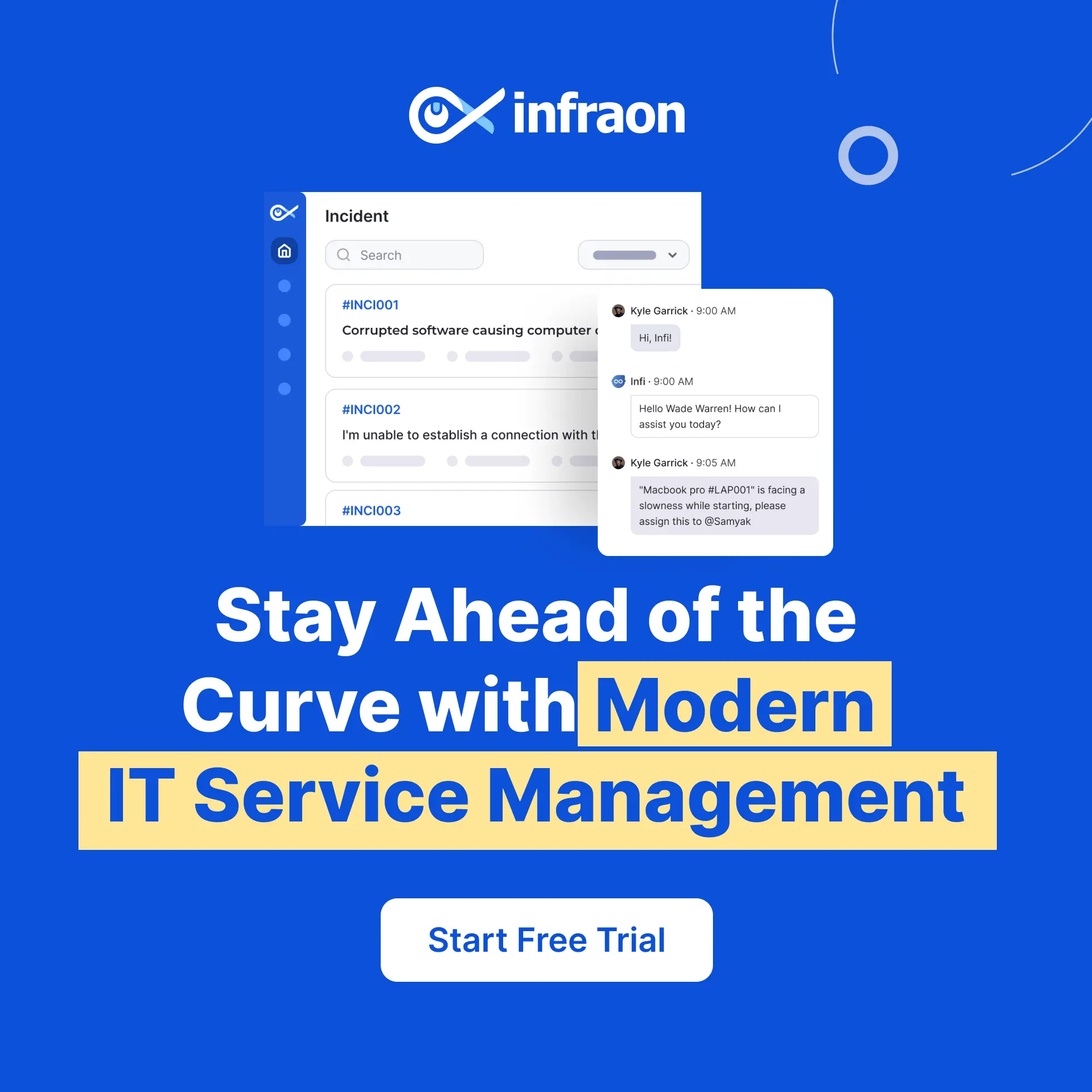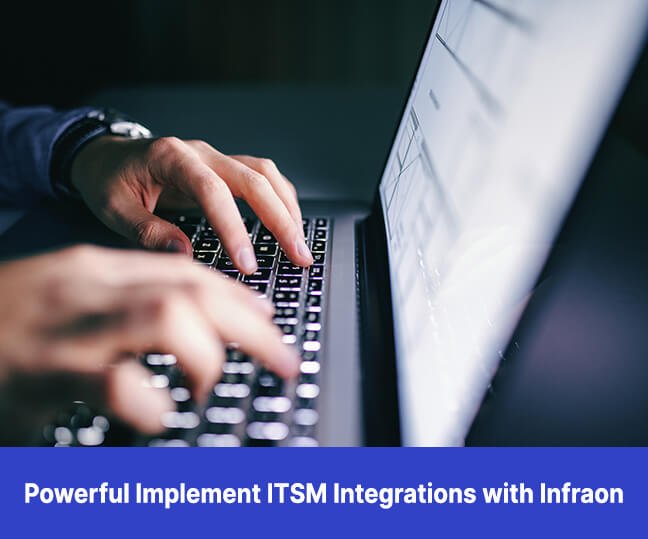Are you looking for an alternative to Jira Service Management? You’ve come to the right place. We’ve compiled a list of options that offer similar functionality. Since this platform is primarily designed for IT teams and comes with robust help desk and customer support features, it can be easily utilized in various industries. As a result, we’ve selected competitors to Jira that offer the same scalability and toolset for managing IT service requests, ticketing, self-service, and other business operations.
While Jira Service Management is a widely used platform that offers robust help desk and customer support tools, there may be various reasons for considering alternatives to it. Here are some reasons why you might want to explore other options:

Steep Learning Curve
Jira Service Management can be complex, especially for users who are unfamiliar with the Jira ecosystem. Due to its robust feature set and extensive configuration options, Jira Service Management can have a steep learning curve. Users may require time and training to utilize its functionalities effectively.
Customization Overhead
While Jira Service Management offers excellent flexibility for customization, this can also come with additional overhead. Extensive customization may require technical expertise or dedicated resources to set up and maintain, potentially increasing the time and effort necessary for configuration.
Limited Customer Support
Depending on the licensing plan and support level chosen, access to customer support for Jira Service Management may be limited. Users may face challenges in obtaining timely assistance or resolving issues, especially if they opt for lower-tier support plans.
Integration Challenges
While Jira Service Management offers integrations with various tools and systems, integrating with specific platforms may present challenges. Compatibility issues or limited integration capabilities can hinder seamless workflows and data synchronization between different systems.
Licensing Costs
Jira Service Management is commercial software with licensing costs, which can increase as the number of users or the complexity of the setup grows. The licensing fees may be a drawback for small businesses or organizations with budget constraints.
Related blog: Jira ITSM Pricing Plan & Cost Guide
How to Choose Jira Service Management Alternative?
When choosing a Jira Service Management alternative, consider the following factors to find the best fit for your organization:

Feature Comparison
Evaluate the features and functionalities offered by alternative service management tools. Identify the key features that are essential for your organization’s specific needs, such as ticket management, self-service portals, automation capabilities, reporting, asset management, integrations, and collaboration tools. Compare these features with different alternatives to ensure they align with your requirements.

Scalability
Assess the scalability of alternative tools to accommodate your organization’s growth. Consider factors such as the ability to handle increasing ticket volumes, support for multiple teams or departments, and the tool’s capacity to adapt to changing business needs.
Ease of Use and User Experience
Evaluate the user interface, intuitiveness, and ease of use of alternative service management tools. A user-friendly interface and streamlined workflows can enhance user adoption and productivity within your organization. Look for demos, trials, or user reviews to gauge the user experience of different tools.
Customization and Configuration

Determine the level of customization and configuration options provided by alternative tools. Consider whether they can be tailored to fit your organization’s specific processes and workflows. Evaluate the flexibility to adapt the tool to your existing ITSM practices and the effort required for customization.
Integration Capabilities
Assess the integration options available with alternative tools. Determine if they can integrate with other critical systems and tools that your organization relies on, such as collaboration platforms, project management software, monitoring tools, or customer relationship management (CRM) systems. Seamless integration can improve efficiency and streamline processes.
Cost and Licensing

Evaluate the pricing structure and licensing models of alternative service management tools. Consider factors such as upfront costs, ongoing maintenance fees, user-based licensing, and any additional costs for advanced features or add-ons.
Align the costs with your budgetary constraints and ensure that the chosen alternative provides value for your investment.
Support and Documentation
Assess the level of customer support offered by alternative tools. Determine the availability of documentation, knowledge bases, user communities, and forums for self-help. Additionally, consider the responsiveness and expertise of the support team to address any technical issues or provide assistance when needed.
Reviews and Recommendations
Research reviews and recommendations from other organizations or industry experts who have used or evaluated the alternative tools. Consider their feedback and experiences to gain insights into the strengths and weaknesses of each option.
By considering these factors and conducting a thorough evaluation, you can make an informed decision when choosing a Jira Service Management alternative that best meets your organization’s needs and goals.
25 Best Jira Service Management Alternatives

While Jira Service Management may initially seem like the ideal ticketing tool, it does have its drawbacks. From a complex and outdated interface to costly plans, there are several areas where users may feel the need to explore alternatives.
In this blog, we will present 25 Jira Service Management alternatives that can provide your team with the versatility and capabilities to satisfy end users.
ServiceNow IT Service Management
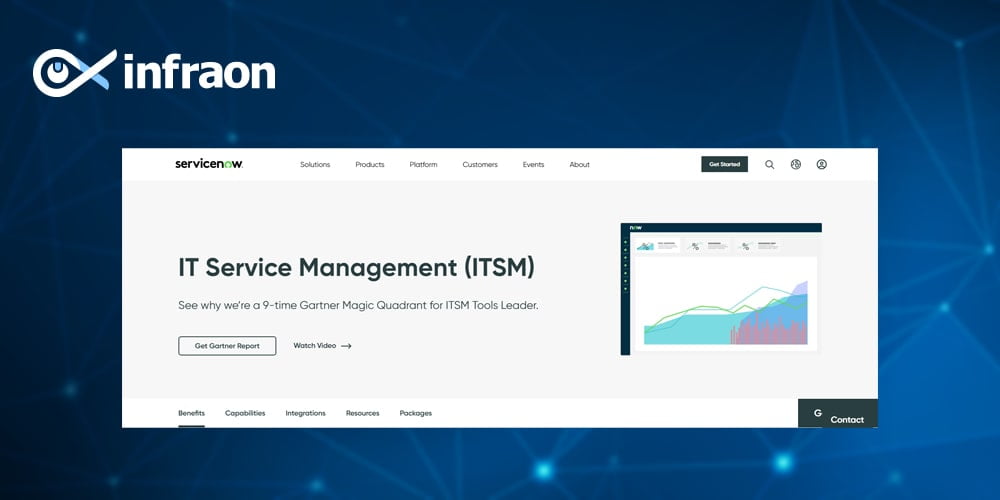
ServiceNow IT Service Management (ITSM) is a cloud-based platform that offers a suite of tools and functionalities to help organizations manage their IT services and support processes effectively. It provides a centralized system for handling service requests, incidents, problems, changes, and other IT-related tasks. It offers automation capabilities that streamline and automate routine tasks, reducing manual effort and increasing operational efficiency.
Pros:
- Comprehensive IT service management solution.
- Customizability and flexibility to align with specific requirements.
- Automation capabilities for increased efficiency and productivity.
- Integration with other IT systems and third-party applications.
- Scalability to accommodate organizations of all sizes.
Cons:
- Steep learning curve and complexity.
- Higher licensing and implementation costs.
- Potential challenges with extensive customization and future upgrades.
Infraon ITSM
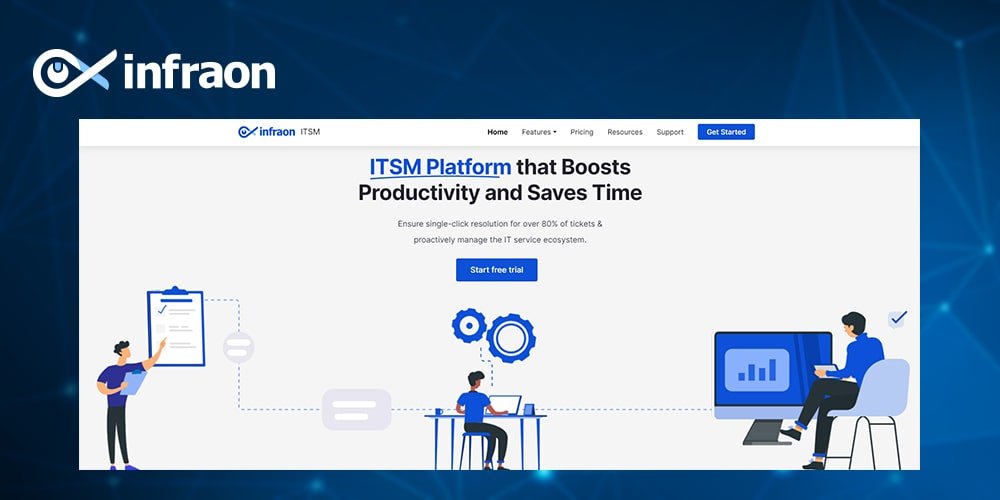
Infraon ITSM is an integrated platform to support your entire IT service management journey with workflow automation. It provides SMEs, large enterprises, and telecom companies with unified and proactive service capabilities. With its intuitive interface and automation features, Infraon ITSM empowers IT teams to provide exceptional service experiences while driving productivity and maximizing the value of their IT services. Additionally, Infraon ITSM provides a self-service portal that empowers end-users to submit service requests, access knowledge articles, and track the status of their tickets, promoting self-sufficiency and reducing the burden on IT support teams.
Powered by an AI-led, user-friendly dashboard, Infraon ITSM enables your DevOps, IT, and business teams to work cohesively and respond to incidents or other issues on a 24X7 basis. It is one of the very few ITSM tools in the market that have been certified as ITIL compatible for 13 processes by Pink Elephant! The software provides a centralized platform for IT teams to efficiently log, track, and resolve IT issues, ensuring timely resolution and minimizing service disruptions.
Pros:
- AI-enabled ITSM software helps in auto-allocation and ticket categorization.
- Ensures single-click resolution for over 80% of tickets & proactively manages the IT service ecosystem.
- It is a low-code and collaborative platform which can streamline and accelerate the IT service management lifecycle.
- Offers single-screen navigation for tickets.
- Provides self-service portal with detailed knowledge base.
- Provides advanced ITAM system that helps manage assets via agent/agent-less discovery.
- Offers better control over asset lifecycle including software asset management and software license management.
- Provides end-to-end SLA management that is suitable for SMBs and large enterprises.
- The software is GDPR-compliant and SOC2 Type2 certified.
Cons:
- It is not available as an on-premises version.
- The software lacks a project management module.
- It is not suitable for enterprises that use complicated workflows.
Zendesk Support Suite
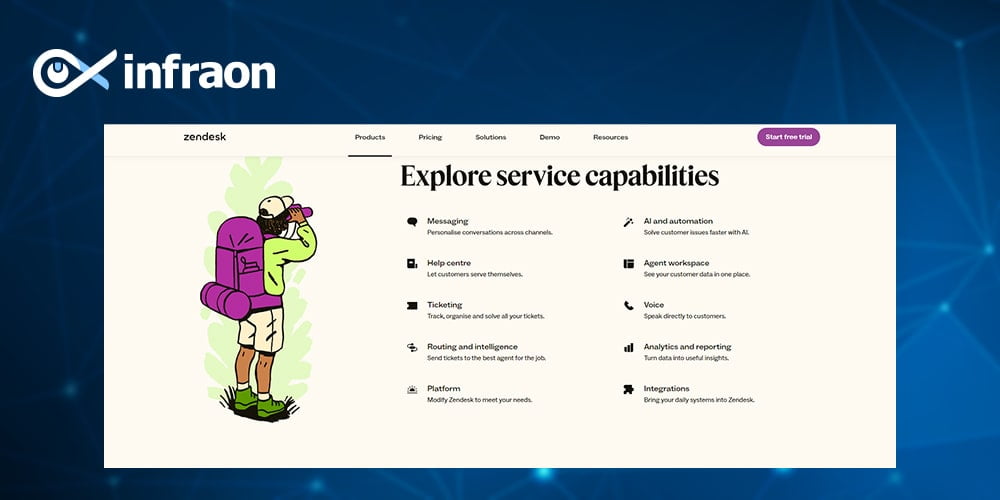
Zendesk Support Suite is a comprehensive customer support software solution designed to help organizations effectively manage and resolve customer inquiries and issues. It offers a range of tools and features to streamline support processes and deliver exceptional customer experiences. With Zendesk Support Suite, businesses can centralize their support operations, consolidate customer interactions from various channels, and provide timely and personalized support to their customers.
One of the key strengths of Zendesk Support Suite is its omnichannel support capabilities. It allows businesses to manage customer interactions from multiple channels such as email, chat, phone, social media, and self-service portals within a single, unified platform. This enables support agents to have a holistic view of customer interactions, ensuring consistent and seamless support across channels. Zendesk Support Suite also offers automation features, including ticket routing, automated responses, and self-service options, which help organizations streamline their support workflows, reduce manual effort, and improve response times.
Pros:
- IVR call routing feature is available for efficient call management.
- Seamlessly integrates with a wide range of applications, including popular ones like JIRA and monday.com, offering extensive compatibility.
- The interface of the software is designed to be intuitive and user-friendly, ensuring easy navigation and accessibility.
- Provides a special offer of six months of free service for eligible early-stage startups, supporting their growth and success.
Cons:
- The cost per agent is comparatively higher than Freshdesk, its top competitor.
- Certain users encountered difficulties in receiving adequate assistance from customer support.
- Several users reported issues with call quality.
- Zendesk does not provide international phone numbers for customer support.
Freshservice
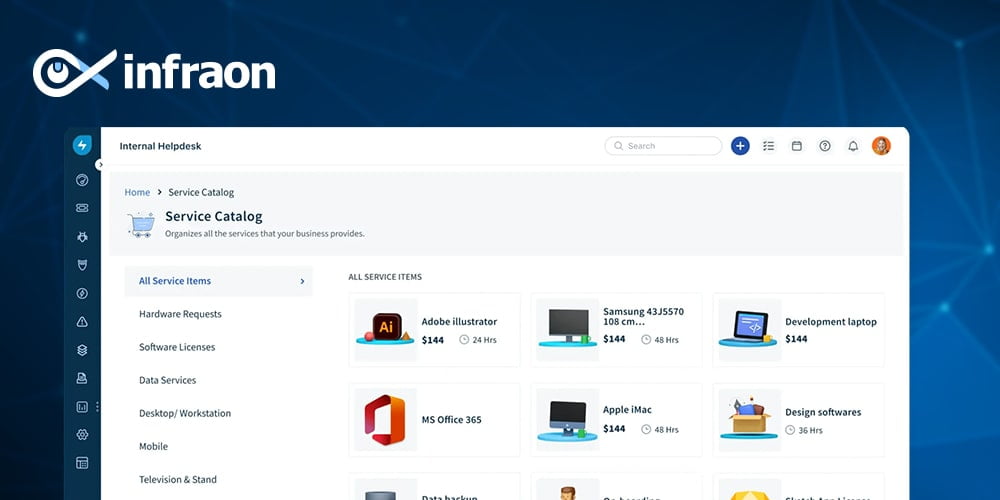
FreshService is a cloud-based IT service management (ITSM) software that offers a comprehensive set of tools and features to streamline and enhance IT service delivery processes. Designed with simplicity and usability in mind, FreshService provides organizations with a user-friendly platform for managing incidents, service requests, changes, problems, and assets. Its intuitive interface and easy navigation enable IT teams to quickly log, track, and resolve issues, ensuring efficient service delivery and minimal disruption to operations.
One of the key strengths of FreshService is its focus on automation and efficiency. The software offers robust workflow automation capabilities, allowing organizations to automate repetitive tasks, escalate incidents, and route requests to the appropriate teams automatically. This automation not only saves time but also reduces the risk of errors and ensures consistent service delivery. FreshService also provides a powerful knowledge base where organizations can store and share information, enabling end-users to find self-help resources and reduce their reliance on IT support.
Related blog: Freshservice Asset Pricing Plan And Cost Guide
Pros:
- The user interface (UI) is modern and visually appealing.
- Provides a unified platform for creating, managing, and notifying others about tickets.
- Seamless integration with various other services.
- The dashboard is intuitive, providing valuable insights and information.
- Offers robust ticket automation and workflow automation capabilities.
Cons:
- The initial setup/configuration can be somewhat complex.
- There is room for improvement in the knowledge base functionality.
- The reporting capabilities are subpar.
- It lacks sufficient integrations with other applications.

SolarWindsService Desk
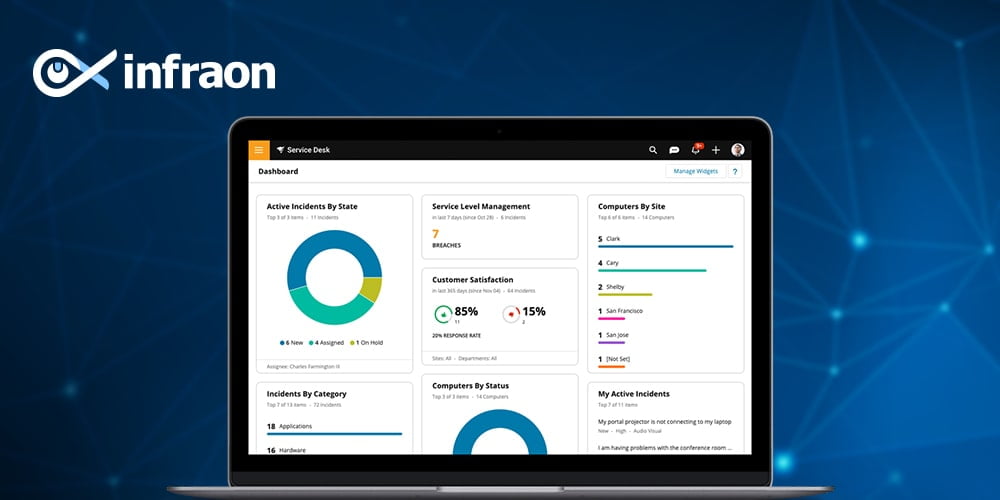
SolarWinds Service Desk is a comprehensive IT service management (ITSM) solution, similar to Jira Service Desk, offering a wide range of powerful features. Its incident management capabilities empower you to efficiently handle and prioritize incoming incidents from a centralized platform.
With SolarWinds Service Desk, you can accelerate service requests through a user-friendly employee service portal. Also, staff members can effortlessly track the status of their ongoing tickets and access the associated SLAs, ensuring transparency and accountability.
Pros:
- Ease of use and configuration
- Flexible creation of self-service forms
- Resolve problems from anywhere using the service desk mobile app
Cons:
- Limited Reporting
- Complicated and outdated interface
- Email integration needs to be improved
- Steep learning curve
- Lack of customization and integration options
- The basic plan misses out on key features
- Limited integration with other applications
SummitAI Service Management
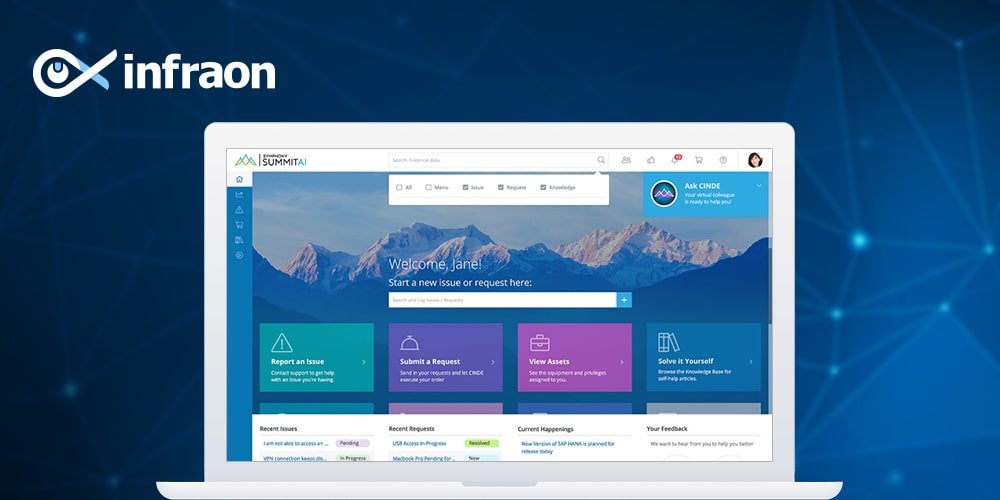
SummitAI Service Management is an advanced and comprehensive solution designed to streamline and optimize service management processes within organizations. It offers a wide range of features and capabilities to effectively manage IT services and support operations. With SummitAI, organizations can automate and simplify their service management workflows, enhancing efficiency, productivity, and customer satisfaction.
One of the key strengths of SummitAI Service Management lies in its robust incident management capabilities. It allows organizations to efficiently handle and resolve incidents or service requests through a centralized platform. The system enables users to log, categorize, prioritize, and assign incidents to the appropriate teams or technicians. With its intelligent routing and escalation mechanisms, SummitAI ensures that incidents are addressed promptly and according to predefined service level agreements (SLAs). The solution also provides real-time visibility into incident status and progress, facilitating effective communication and collaboration among stakeholders.
Pros:
- Offers flexibility in managing workflows and support.
- Ease of implementation, configuration, and changes.
- Can be used to automate all kinds of service management.
Cons:
- Lack of Network monitoring and patch management functionality.
- The support team often takes an extended period to address new requirements, causing delays in resolution
- Some interfaces, particularly the administrative sections, are clunky and require improved documentation.
TOPdesk
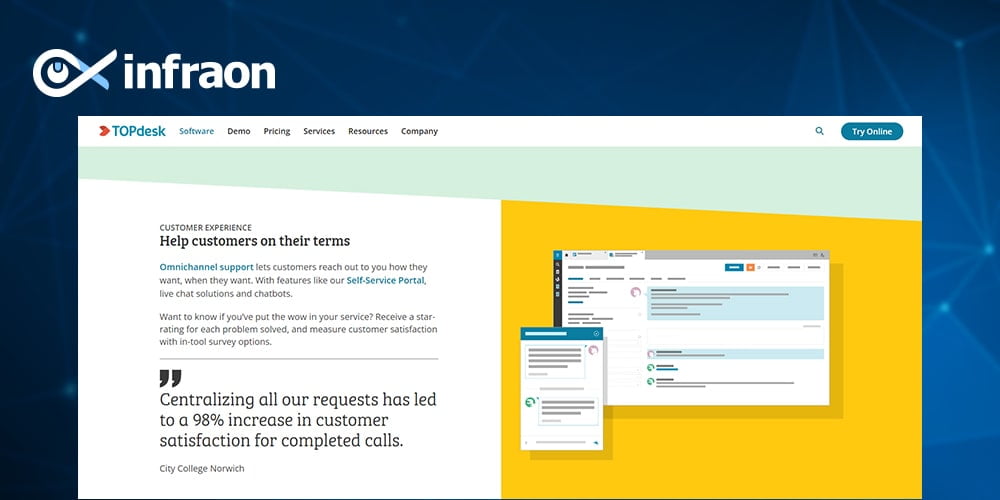
TOPdesk is a comprehensive software suite that enables organizations to streamline their IT support, facilities management, and other service-related processes. It offers a wide range of functionalities to efficiently manage and automate IT service operations, including incident management, change management, problem management, asset management, and self-service portals.
TOPdesk provides a comprehensive solution for organizations to manage their IT service management (ITSM) and computer-aided facility management (CAFM) processes. It offers modules and tools to effectively handle employees, users, assets, and facilities. The ITSM tools automate tasks such as reporting incident resolution times, managing complaints and requests, scheduling employee workload, and more. The CAFM modules allow users to handle facilities-related tasks such as tracking company assets, processing work orders, planning maintenance, registering properties, monitoring visitors, and managing reservations.
Pros:
- The web interface is highly responsive and user-friendly.
- Exceptional customer support is provided.
- Offers the ability to generate reports based on Key Performance Indicators (KPIs).
Cons:
- Not all complex workflows can be accommodated.
- Limited design options for knowledge items and the self-service portal.
- As a Software-as-a-Service (SaaS) platform, it cannot be hosted on a private server.
- Requires a significant amount of time for system customization and employee training.
Cherwell Service Management
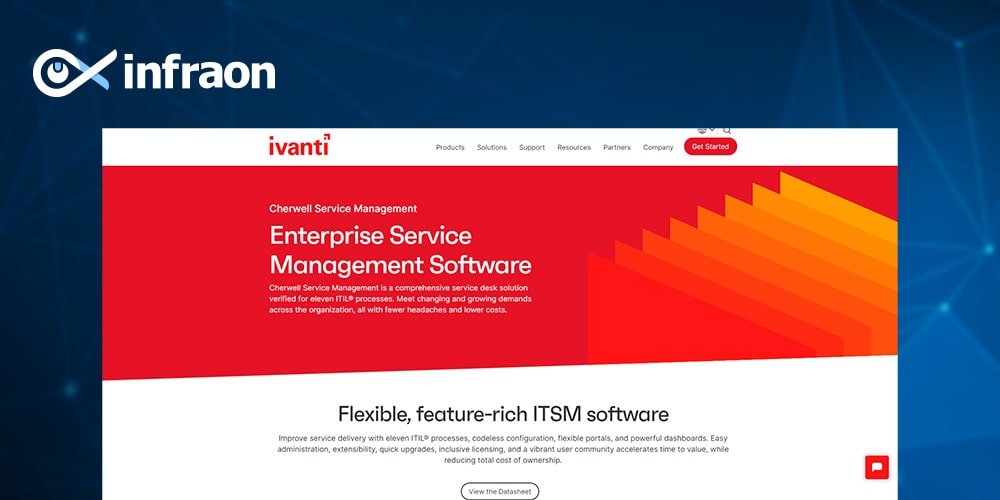
Cherwell Service Management is a robust and versatile IT service management (ITSM) software solution that helps organizations streamline and optimize their IT service delivery processes. With its comprehensive set of features and functionalities, Cherwell enables businesses to effectively manage incidents, problems, changes, and service requests. It provides a centralized platform where IT teams can log, track, and resolve issues efficiently, ensuring minimal disruption to operations.
Cherwell offers a user-friendly interface that allows for easy navigation and quick access to relevant information, empowering IT staff to deliver timely and high-quality service to end users. One of the standout features of Cherwell Service Management is its flexibility and customization capabilities. Organizations can tailor the system to align with their specific workflows and requirements, allowing for more seamless integration into existing processes.
Pros:
- The dashboard customization options in Cherwell Service Management are highly flexible.
- It provides an excellent out-of-the-box ITIL framework.
- Cherwell allows extensive customization and seamless integration with other software solutions.
Cons:
- Outdated web components: The web portal and browser client do not keep pace with modern web technologies.
- The steep learning curve for the built-in reporting engine.
- The user interface of Cherwell lacks modern capabilities like responsive forms and CSS styling for web portals.
SysAid
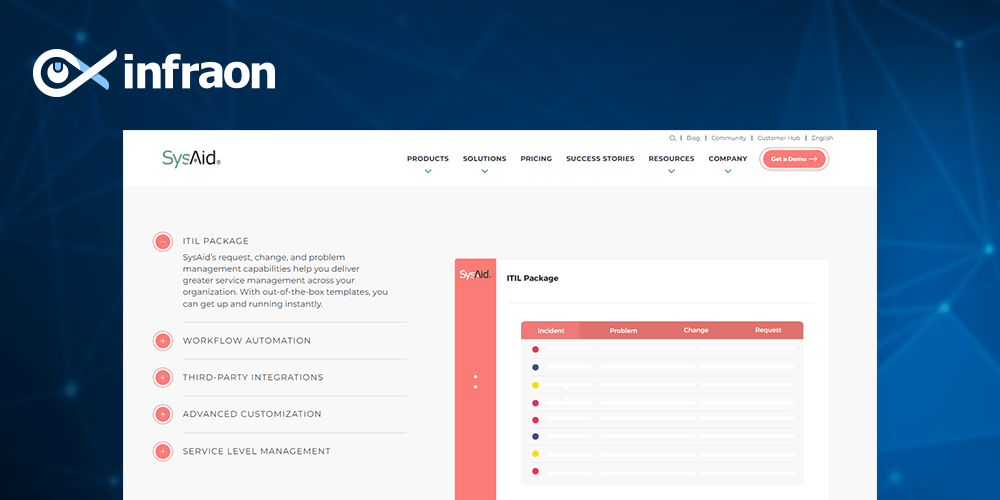
SysAid is a comprehensive IT service management (ITSM) and help desk software that offers organizations a range of tools and features to effectively manage their IT services and support processes. With its user-friendly interface and robust functionalities, SysAid enables IT teams to efficiently handle incidents, service requests, problems, changes, and asset management. It provides a centralized platform for logging and tracking issues, automating workflows, and ensuring timely resolution to minimize service disruptions.
One of the notable strengths of SysAid is its flexibility and customization options. Organizations can tailor the system to align with their unique workflows and requirements, allowing for seamless integration into existing processes. SysAid’s drag-and-drop interface enables easy customization of forms, fields, and workflows, empowering organizations to optimize their IT service management processes. The software also offers robust reporting and analytics capabilities, allowing organizations to gain insights into service performance, track key metrics, and make data-driven decisions to continuously improve their IT operations.
Pros:
- Seamless integration with existing business processes has been achieved effortlessly.
- The product can be implemented smoothly, provided that the necessary prerequisites are met.
- The ticketing system of the software offers a wide range of workflow templates for incidents, requests, changes, and problem classifications, facilitating efficient handling of IT service management processes.
Cons:
- There is no available on-premises mobile application version.
- Some users find the workflow and asset management functionalities to be less intuitive.
- The system has room for improvement in adapting to new types of assets and services.
BMC Helix ITSM
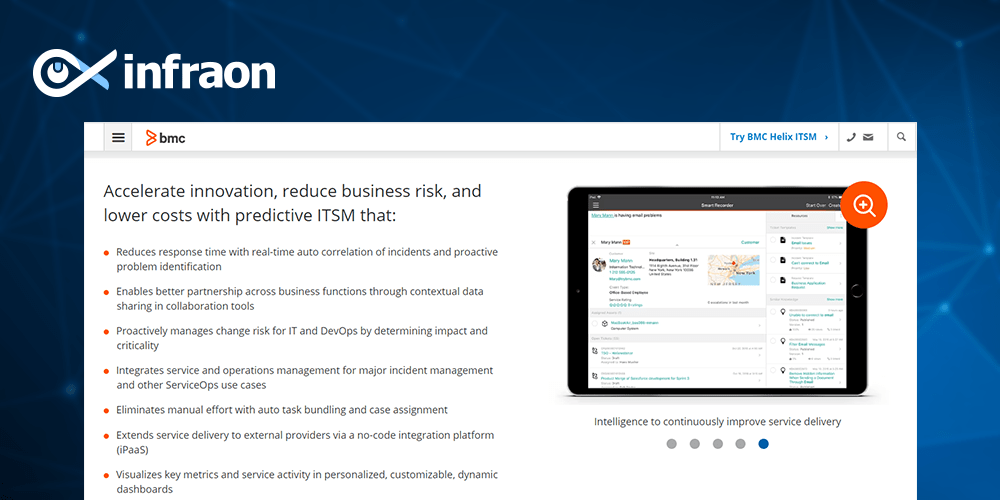
BMC Helix ITSM is a comprehensive IT service management (ITSM) solution that offers organizations a powerful set of tools and capabilities to streamline their IT service delivery and support processes. With its advanced features and automation capabilities, BMC Helix ITSM helps organizations effectively manage incidents, service requests, changes, problems, and assets. The software provides a centralized platform for logging, tracking, and resolving issues, ensuring prompt and efficient resolution to minimize service disruptions.

One of the standout features of BMC Helix ITSM is its intelligent automation capabilities. The software leverages artificial intelligence (AI) and machine learning (ML) technologies to automate repetitive tasks, route requests to the right teams, and even predict and prevent future incidents. This helps organizations reduce manual effort, improve operational efficiency, and deliver faster and more consistent IT services. BMC Helix ITSM also offers a self-service portal that empowers end-users to log their own incidents, access knowledge articles, and track the progress of their requests, reducing the reliance on IT support and enhancing user satisfaction.
Pros:
- Change Management is fully supported by the software.
- Incident Management is effectively facilitated by the tool.
- The tool includes embedded Request Management capabilities.
- The implementation timeframe is remarkably short, ensuring a swift deployment.
- By eliminating multiple legacy tools, the software aids in standardization.
- Workflows can be easily defined to track the request and incident management process.
Cons:
- The software has a moderate learning curve and may not be as intuitive for new users.
- It requires some time and practice to become proficient with the tool.
- Navigating through hundreds of groups using a small arrow can be cumbersome and time-consuming.
- Creating change requests can be challenging and may require extensive practice to master.
Related blog: BMC Helix ITSM (Remedy) Pricing 2023
BMC Remedy
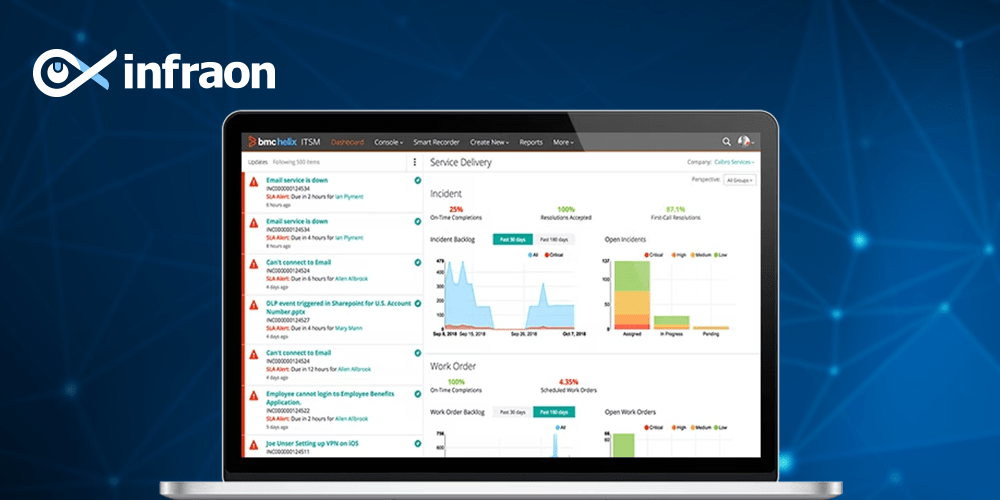
BMC Remedy is a powerful and widely-used IT service management (ITSM) solution that provides organizations with a comprehensive set of tools and functionalities to streamline their IT service delivery processes. With its robust features and capabilities, BMC Remedy enables IT teams to effectively manage incidents, service requests, changes, problems, and assets.
The software offers a centralized platform for logging, tracking, and resolving IT issues, ensuring timely resolution and minimizing service disruptions. One of the key strengths of BMC Remedy is its scalability and flexibility. The software can be tailored to meet the specific needs and workflows of organizations of all sizes. It provides extensive customization options, allowing organizations to adapt the system to their unique requirements and integrate it seamlessly into their existing IT infrastructure.
Pros:
- Comprehensive ITSM Functionality.
- It offers extensive configuration options, enabling organizations to adapt the system to match their unique requirements.
- It can handle a large volume of tickets, users, and assets without compromising performance.
- The software provides robust reporting and analytics capabilities.
Cons:
- The initial setup process for BMC Remedy can be challenging and requires technical expertise.
- Users may experience inconsistencies and limited cross-platform integration across different modules of BMC Remedy.
- Resolving issues within BMC Remedy can sometimes be time-consuming, and users may encounter frustrations when working with back-end teams, often requiring escalation for resolution.
CA Service Desk Manager
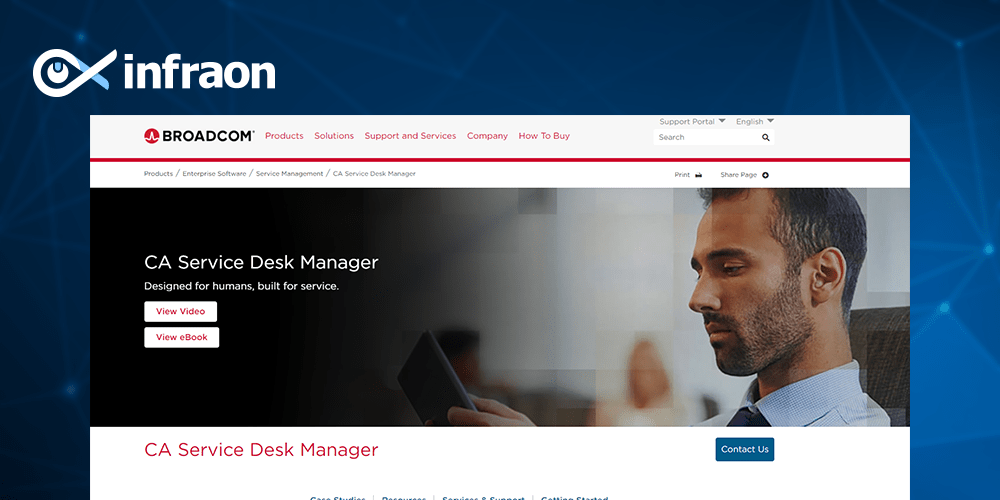
CA Service Desk Manager (CA SDM) is a comprehensive and robust IT service management (ITSM) software solution designed to help organizations effectively manage their IT services and support processes. With its wide range of features and functionalities, CA SDM enables IT teams to efficiently handle incidents, service requests, changes, problems, and assets. The software provides a centralized platform for logging, tracking, and resolving IT issues, ensuring timely resolution and minimizing service disruptions.
It supports ITIL (Information Technology Infrastructure Library) best practices, ensuring compliance and alignment with industry standards. CA SDM can be easily integrated with other IT systems and applications, providing a seamless experience and allowing for efficient data exchange.
Pros:
- It offers scalability, making it suitable for organizations of any size, from small businesses to large enterprises.
- It provides a convenient patching utility and support site where users can easily download the latest patches. This feature is particularly valuable as not all software products offer seamless software patching capabilities.
- Additionally, CA Service Desk Manager includes a PDA site for easy access to personal digital assistants, and newer versions even offer a dedicated mobile app.
Cons:
- The absence of a right-click copy-and-paste feature in version 12.6 of CA Service Desk Manager on major forms and fields can be a significant inconvenience for users.
- CA Service Desk Manager has been known to have occasional bugs, and if these issues are not promptly addressed, it can potentially undermine customer confidence in the product. Therefore, having a skilled administrator is crucial to ensure timely bug resolution.
- CA Service Desk Manager may exhibit sensitivity to its environment, necessitating a full system reboot on a monthly basis to maintain optimal performance.
ManageEngine ServiceDesk Plus
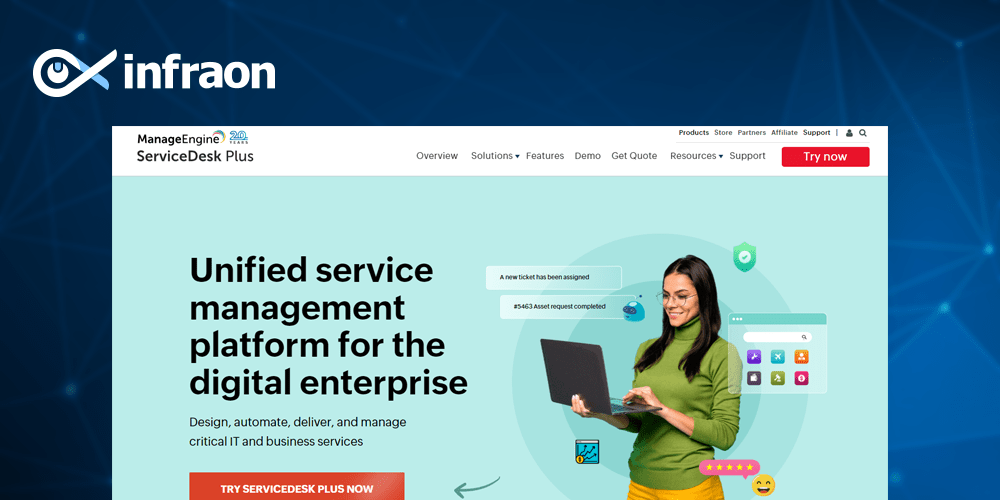
ManageEngine ServiceDesk Plus is a comprehensive help desk and IT service management (ITSM) solution designed to streamline and automate IT service desk operations, enabling organizations to effectively manage and resolve IT-related issues and requests. It is available as both an on-premises installation and a cloud-based solution.
It caters to organizations of all sizes and industries, including IT service providers, educational institutions, healthcare organizations, government agencies, and more. Overall, ServiceDesk Plus provides organizations with a comprehensive set of tools to effectively manage IT service delivery, improve productivity, and enhance end-user satisfaction.
Pros:
- Easy to configure and customize
- Low resource consumption on a server
- Built-in reporting
- Excellent service catalog
Cons:
- Limited customization capabilities
- Support is limited
- Complicated CMDB part
TeamDynamix ITSM

TeamDynamix ITSM is a comprehensive IT service management (ITSM) solution that empowers organizations to effectively manage their IT services and support operations. With its robust features and intuitive interface, TeamDynamix ITSM streamlines IT processes, improves efficiency, and enhances the overall user experience. The software offers a range of functionalities, including incident management, problem management, change management, asset management, and service catalog management.
With its built-in collaboration tools, organizations can easily assign and track tasks, share knowledge, and collaborate on resolving issues. Furthermore, TeamDynamix ITSM offers seamless integration capabilities, allowing organizations to connect with other systems and applications, such as monitoring tools and project management platforms, to streamline workflows and enhance productivity.

Pros:
- TeamDynamix makes tracking and reporting tickets and projects easy.
- It has multiple layers of built-in automation out of the box.
- Ease of use and thorough implementation experience.
Cons:
- The search features in TeamDynamix aren’t the best.
- Currently, dashboards do not display data in real time.
- The product requires pretty extensive customization to get up and running.
ServicePRO
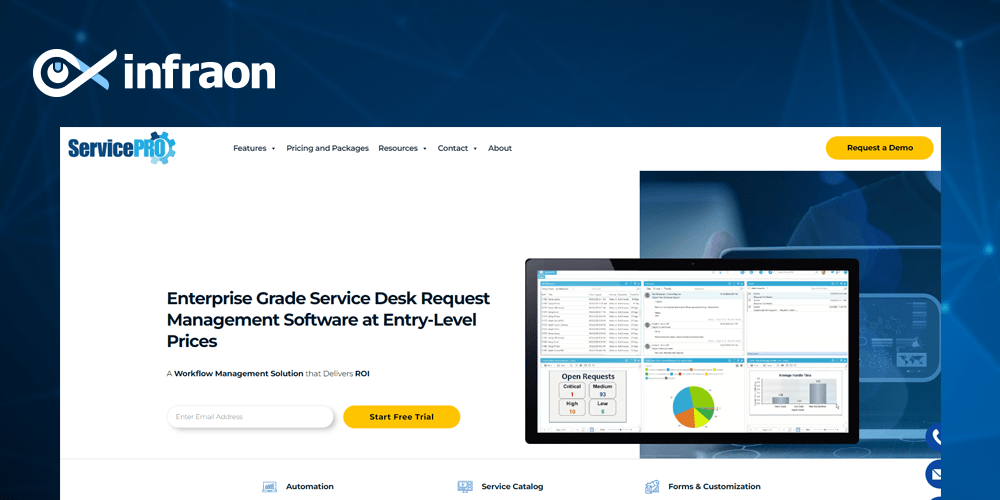
ServicePRO is a robust IT service management (ITSM) software solution designed to streamline IT service delivery and support processes. With its comprehensive set of features and functionalities, ServicePRO enables organizations to efficiently manage incidents, service requests, changes, problems, and assets. The software provides a centralized platform for logging, tracking, and resolving IT issues, ensuring timely resolution and minimizing service disruptions.
The software offers extensive customization options, allowing organizations to tailor the system to their specific workflows and requirements. It supports ITIL (Information Technology Infrastructure Library) best practices, ensuring compliance and alignment with industry standards. ServicePRO is highly scalable and can easily adapt to the changing needs of organizations, making it suitable for businesses of all sizes. Additionally, the software provides multi-site and multi-lingual capabilities, allowing organizations with distributed teams or global operations to effectively manage IT services across different locations.
Pros:
- It is highly customizable, allowing organizations to tailor the software to their specific workflows and requirements.
- It offers extensive configuration options, enabling users to adapt the system to match their unique processes and integrate it seamlessly with their existing IT infrastructure.
- It provides a user-friendly interface that is intuitive and easy to navigate.
Cons:
- Steep learning curve
- Limited reporting and analytics
- The level of integration and compatibility with external tools may vary, which could require additional effort and resources to ensure smooth integration and data exchange.
4me
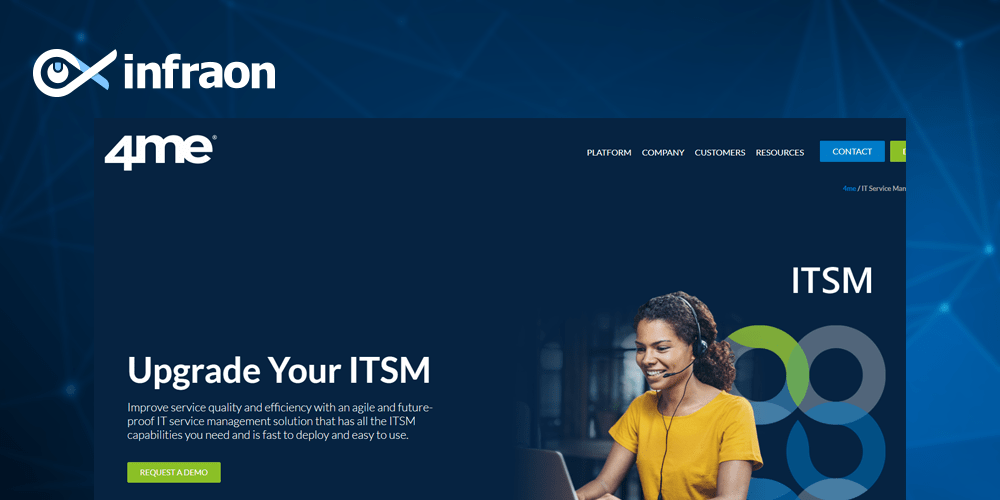
4me is a robust IT service management (ITSM) and enterprise service management (ESM) platform designed to optimize service delivery and support processes. With its comprehensive set of features and capabilities, 4me helps organizations efficiently manage incidents, service requests, changes, problems, and assets. The platform offers a unified and centralized view of IT and non-IT services, allowing organizations to streamline operations and improve collaboration across departments.
With its advanced service integration capabilities, organizations can easily connect with external vendors, enabling effective collaboration and ensuring smooth service delivery. Additionally, 4me offers a user-friendly self-service portal that allows end-users to submit and track service requests, access knowledge articles, and receive timely updates, promoting self-sufficiency and enhancing the overall user experience.
Pros:
- The deployment and usage of 4me are user-friendly and intuitive, ensuring a smooth experience for both process users and end-users.
- The out-of-the-box processes provided by 4me require minimal customization and can be easily configured to align with the specific needs of your organization.
- 4me offers built-in security and privacy features, ensuring compliance with regulatory requirements and protecting sensitive data.
- The collaboration capabilities within 4me foster effective communication and teamwork among different teams, promoting efficient service delivery and problem-solving.
Cons:
- The configuration process for connecting with SCCM posed challenges and required extra effort.
- The platform lacks the capability to automatically send email updates from incidents to customers, hindering effective communication and timely updates.
- Users face limitations when searching within the UI Extensions, which can affect the efficiency of locating specific information.
- The absence of a Knowledgebase feature in the platform hampers the ability to store and access valuable knowledge articles and documentation.
System Center – Microsoft
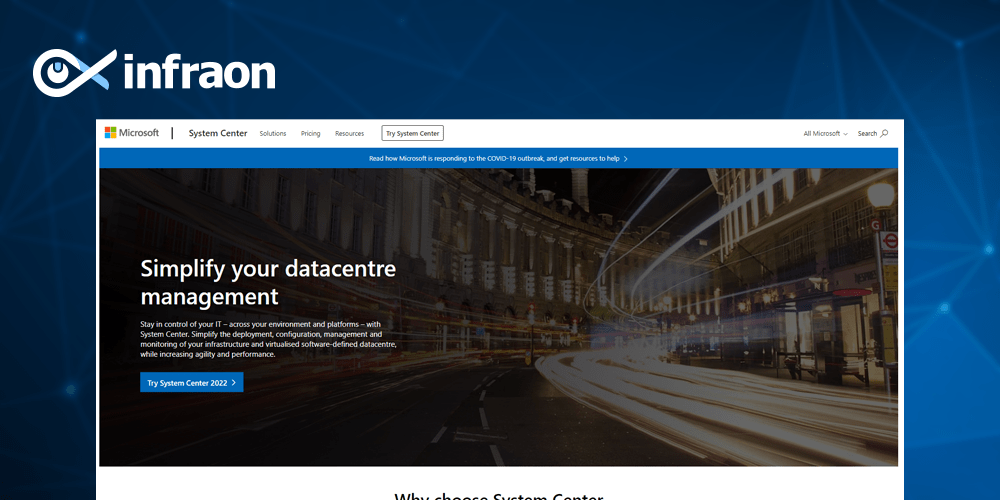
System Center is a suite of management tools and solutions developed by Microsoft that provides a comprehensive and integrated platform for managing and monitoring enterprise IT environments. It offers a range of modules and components that address different aspects of IT management, including configuration management, monitoring, automation, virtualization, and data protection. System Center is designed to simplify and streamline IT operations, improve efficiency, and enhance the overall performance and availability of IT resources.
It provides a unified console that allows administrators to have a holistic view of their IT infrastructure and easily manage multiple components and services from a single interface. System Center offers powerful configuration management capabilities, enabling organizations to efficiently deploy and manage applications, servers, and client devices across their network. It also includes robust monitoring tools that allow administrators to proactively monitor the health and performance of their IT environment, detect and resolve issues, and ensure optimal service levels.
Pros:
- Streamlines IT service operations
- Offers customizable configuration options
- Facilitates application deployment on Windows machines
- Supports provisioning of servers and workstations
Cons:
- The software is expensive.
- The licensing is pretty complicated too.
- There can be a steep learning curve for some of the products.
Agiloft
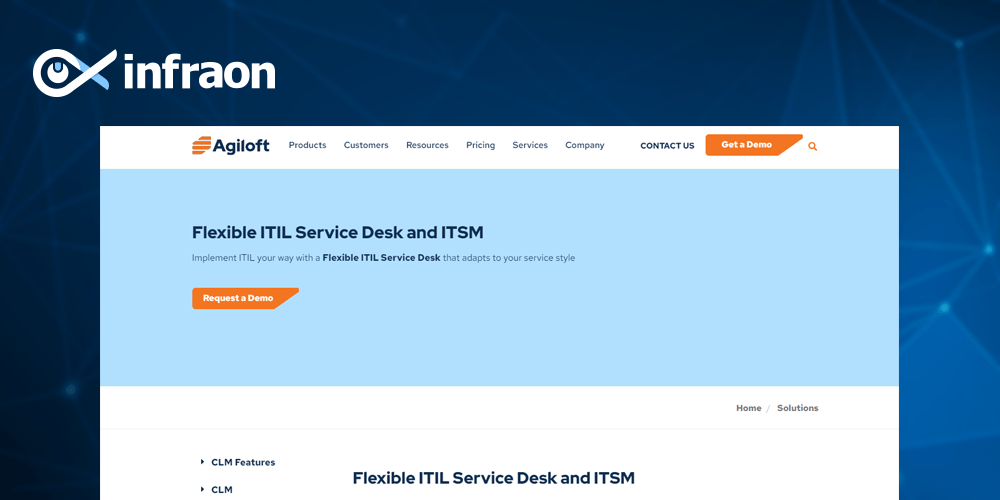
Agiloft is a powerful and flexible contract and workflow management software designed to streamline business processes and improve operational efficiency. With its robust features and configurable workflows, Agiloft empowers organizations to automate and optimize their contract lifecycle management, as well as various other business processes. The platform offers a user-friendly interface that allows users to design and customize workflows without the need for complex coding or programming knowledge.
With its no-code configuration capabilities, users can easily tailor the workflows, data fields, and business rules to align with their unique processes and workflows. This reconfigurability ensures that Agiloft can be effectively implemented across different industries and business functions, providing a tailored solution that fits the specific needs of each organization.
Pros:
- Highly configurable and customizable platform
- Streamlines business processes and workflows
- Robust contract management capabilities
- User-friendly interface with no-code configuration
- Centralized repository for easy access to contract documents
- Advanced search and reporting features
- Integration with other systems and applications
Cons:
- The steeper learning curve for complex configurations
- Initial setup and implementation may require technical expertise
- Customization options may require additional time and effort
- Pricing may be higher compared to some competitors
- Limited out-of-the-box templates and pre-built workflows
- Advanced features may require additional licensing or modules
Spiceworks
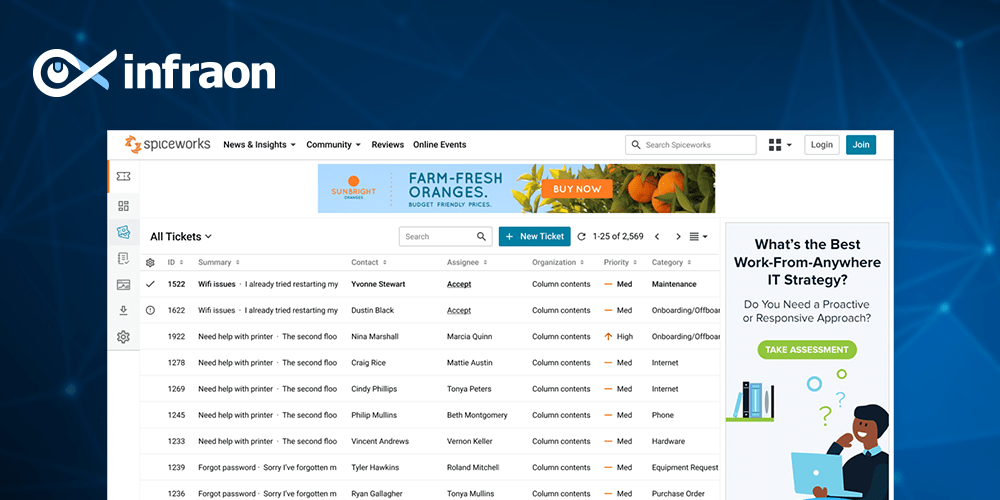
Spiceworks is a popular and widely used IT management software designed to simplify IT operations and provide a range of tools for IT professionals. It offers a suite of features that assist with network monitoring, help desk ticketing, inventory management, and more. One of the key strengths of Spiceworks is its free and community-driven model, making it accessible to organizations of all sizes, including small and medium-sized businesses.
The software provides a centralized dashboard where IT professionals can monitor the health and performance of their network infrastructure, track software, and hardware assets, and manage help desk tickets efficiently. Another notable feature of Spiceworks is its active community of IT professionals. The Spiceworks Community serves as a valuable resource for IT professionals to exchange knowledge, seek advice, and collaborate on various IT-related topics. Users can participate in discussion forums, access helpful articles and tutorials, and share best practices.
Pros:
- Easy implementation
- Free licensing for most critical features
- Simple Reporting
- Great Knowledgebase
Cons:
- The free version of Spiceworks has limitations in terms of scalability and performance, making it less suitable for large organizations with complex IT infrastructures.
- Free users may have limited access to technical support, and response times for support requests can vary.
- The quality and accuracy of the information in the Spiceworks community forums and knowledge base can vary, requiring users to verify and validate the information.
EasyVista Service Manager
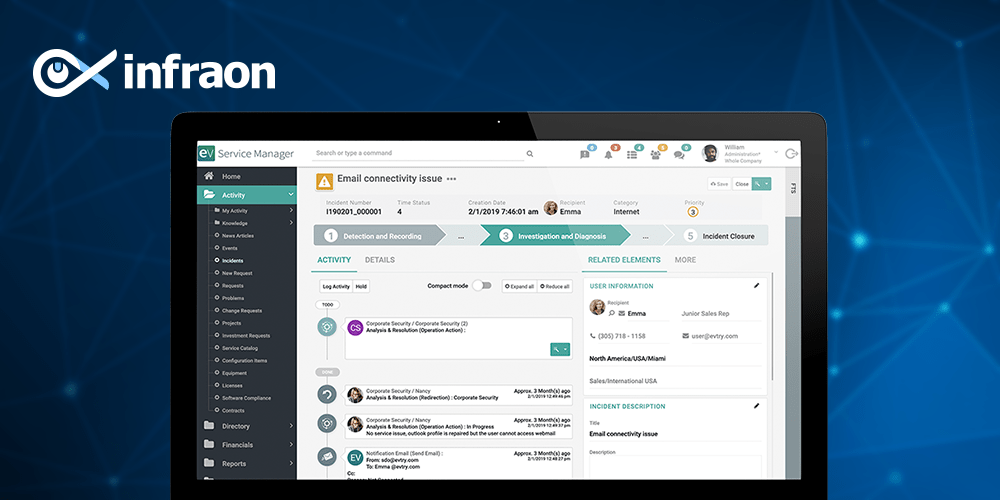
EasyVista Service Manager is a robust and user-friendly ITSM solution that empowers organizations to streamline their service operations and enhance customer satisfaction. With its intuitive interface, self-service capabilities, and automation features, EasyVista Service Manager enables IT teams to effectively manage and resolve incidents, optimize service requests, and improve overall service delivery.
It supports ITIL (Information Technology Infrastructure Library) best practices, providing a framework for organizations to align their IT service management processes with industry standards. The software’s automation features help reduce manual effort, minimize errors, and accelerate service delivery, enabling IT teams to focus on strategic initiatives and higher-value tasks.
Pros:
- Modern user interface
- No need to code to set up even complex workflows
- Out-of-the-box ready-to-use workflows
- The multi-language interface is a plus.
- Email integration can help communications with users.
- On-premises solution is available.
Cons:
- Knowledge base and knowledge management are limited
- Support from Easyvista is slow.
- Few integrations with other tools.
Micro Focus Service Management Automation X (SMAX)
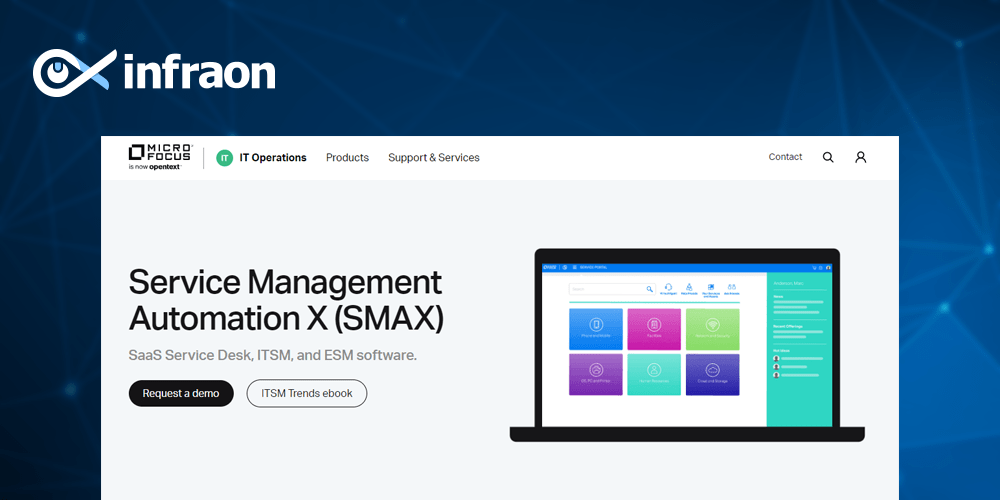
Micro Focus Service Management Automation X (SMAX) is a comprehensive service management solution that combines advanced IT service management (ITSM) capabilities with cutting-edge technologies such as artificial intelligence (AI) and machine learning (ML). SMAX offers a modern and user-centric approach to ITSM, enabling organizations to deliver exceptional service experiences and streamline their service management processes. The platform provides a centralized hub for managing incidents, service requests, problems, changes, and assets, empowering IT teams to effectively handle service operations.

It provides advanced analytics and reporting capabilities that enable organizations to gain valuable insights into their service performance and make data-driven decisions. The platform offers customizable dashboards and reports that provide real-time visibility into key service metrics, helping organizations identify trends, monitor SLAs, and continuously improve their service delivery. With its intuitive interface, intelligent automation, and robust analytics, Micro Focus Service Management Automation X (SMAX) empowers organizations to transform their service management practices, enhance productivity, and deliver exceptional IT services.
Pros:
- SMAX offers excellent support for both IT internal operations and end-users.
- The tool simplifies the management of ITIL processes and seamlessly integrates with other solutions offered by Micro Focus.
- It empowers IT to effectively manage products and services.
Cons:
- The initial setup of Micro Focus Service Management Automation X (SMAX) can be challenging.
- There is a lack of direct/app connection with external tools.
- The UI can be cumbersome and not very user-friendly at times.
InvGate Service Desk
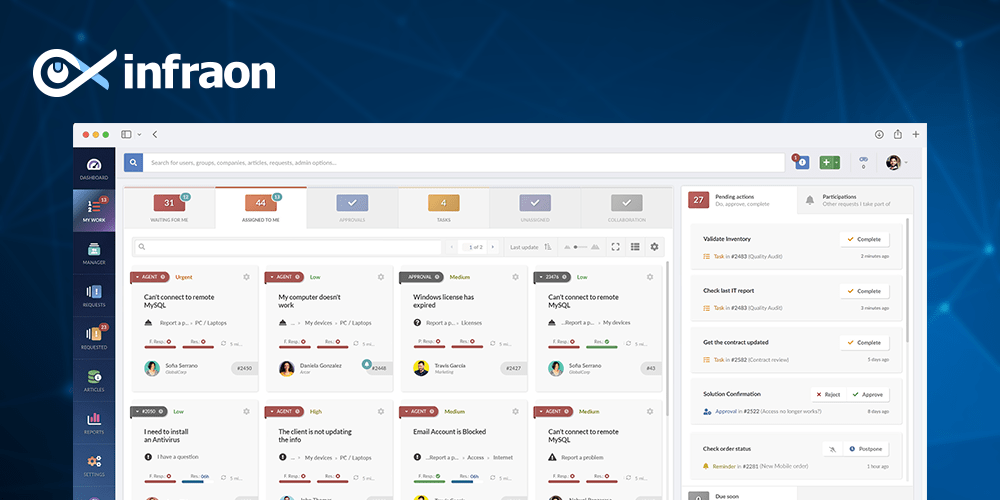
InvGate Service Desk is a powerful and user-friendly ITSM solution that enables organizations to streamline their IT service operations, improve service delivery, and enhance overall efficiency. With its intuitive interface, self-service capabilities, advanced reporting, and automation features, InvGate Service Desk empowers IT teams to provide exceptional service experiences while driving productivity and maximizing the value of their IT services.
The software allows organizations to generate customizable reports and dashboards, providing valuable insights into key IT service metrics, performance trends, and areas for improvement. These analytics help IT teams make data-driven decisions, identify bottlenecks, and optimize service delivery.
Pros:
- User-friendly interface with a clean and intuitive design.
- Comprehensive ticket management system for efficient tracking and resolution of issues.
- A robust self-service portal that allows users to find solutions to common problems independently.
- Customizable workflows and automation capabilities to streamline processes and improve efficiency.
- Integration with external tools and applications, providing seamless connectivity and enhancing collaboration.
Cons:
- The back-end database can be challenging to navigate and lacks clarity, making it difficult to access data.
- There is room for improvement in the reporting functions.
- Building out workflows, including basic onboarding workflows, can be challenging due to their subpar functionality.
Atera
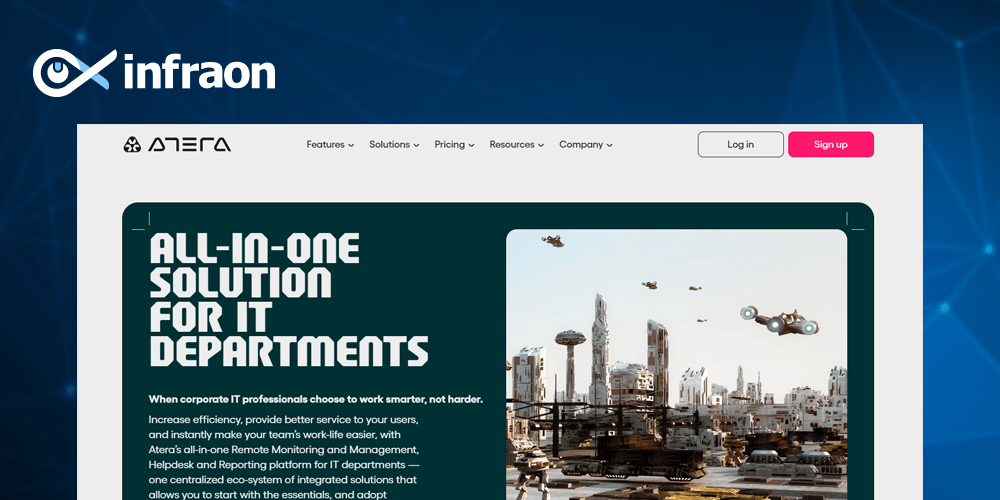
Atera’s all-in-one solution includes remote access, network monitoring, ticketing, billing, and reporting capabilities, providing a holistic approach to IT management. The platform offers a clean and modern interface that is easy to navigate, making it simple for IT professionals to access and manage critical information. Atera’s dashboard provides real-time visibility into the health and performance of clients’ networks, enabling proactive monitoring and rapid issue resolution. Additionally, Atera’s remote access functionality allows IT professionals to securely access and troubleshoot client devices remotely, saving time and minimizing disruptions.
Another notable feature of Atera is its robust ticketing and help desk system. It enables MSPs to effectively manage client requests, assign and track tickets, and provide timely support. Atera’s ticketing system integrates seamlessly with other modules, such as network monitoring and remote access, enabling a streamlined workflow and efficient issue resolution. The platform also offers built-in billing and reporting capabilities, allowing MSPs to generate accurate invoices, track time spent on client tasks, and provide transparent reports to clients.
Pros:
- The software has an intuitive and easy-to-use interface, making it accessible to users of all levels of technical expertise.
- Atera provides proactive monitoring capabilities.
- Atera integrates with various third-party tools and services, enabling you to extend its functionality and integrate with your existing workflows.
Cons:
- Some users may find the level of customization options in Atera to be limited compared to other more advanced RMM and PSA solutions.
- The reporting capabilities in Atera may be considered basic by some users, lacking advanced customization and flexibility.
- Some users have reported occasional performance issues with the software, such as slow loading times or glitches.
Ivanti Neurons for ITSM
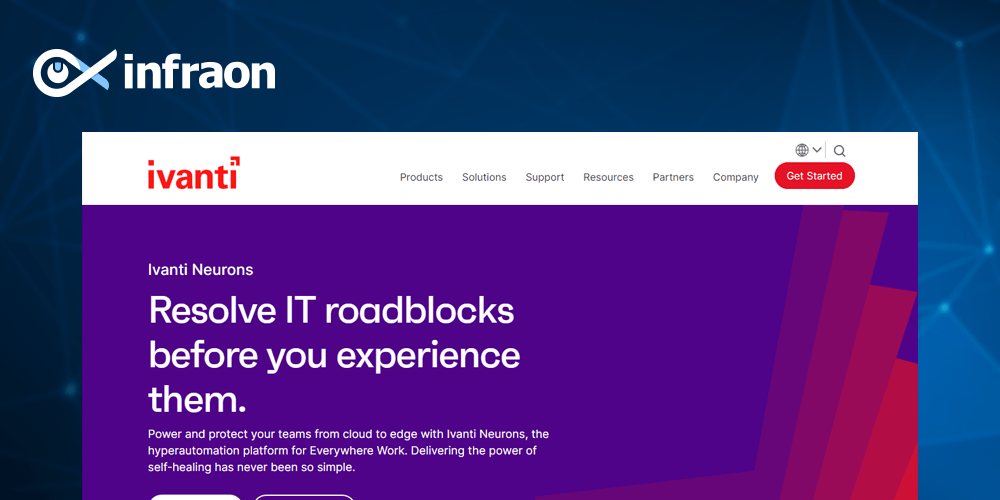
Ivanti Neurons for ITSM is a cutting-edge software solution designed to streamline and optimize IT service management (ITSM) processes within organizations. Built upon the power of artificial intelligence (AI) and automation, Ivanti Neurons for ITSM empowers IT teams to deliver superior service and support to end-users while reducing operational complexities. With its advanced capabilities, it enables organizations to achieve greater efficiency, agility, and customer satisfaction.
By automating processes such as incident resolution, request fulfillment, and change management, the software significantly reduces manual effort and accelerates service delivery. Moreover, it employs natural language understanding to enable conversational self-service, allowing users to interact with the system through chatbots or virtual assistants. This enables faster issue resolution and enhances the end-user experience by providing instant responses and self-help options.
Pros:
- A unified platform that integrates IT service management (ITSM) processes and IT operations management (ITOM) capabilities.
- Comprehensive asset management functionality for effective tracking and management of IT assets.
- Knowledge management features that facilitate self-service and empower users to find solutions independently.
- Strong integration capabilities with various external systems and tools, enabling seamless data exchange and collaboration.
Cons:
- The steep learning curve for administrators and users due to the complexity of the platform.
- Some users may find the initial setup and configuration process time-consuming and challenging.
- Customization options may be limited compared to other ITSM solutions.
- Support and documentation may not always adequately address specific use cases or issues.
- The pricing structure may be higher compared to some competing ITSM solutions.
HaloITSM
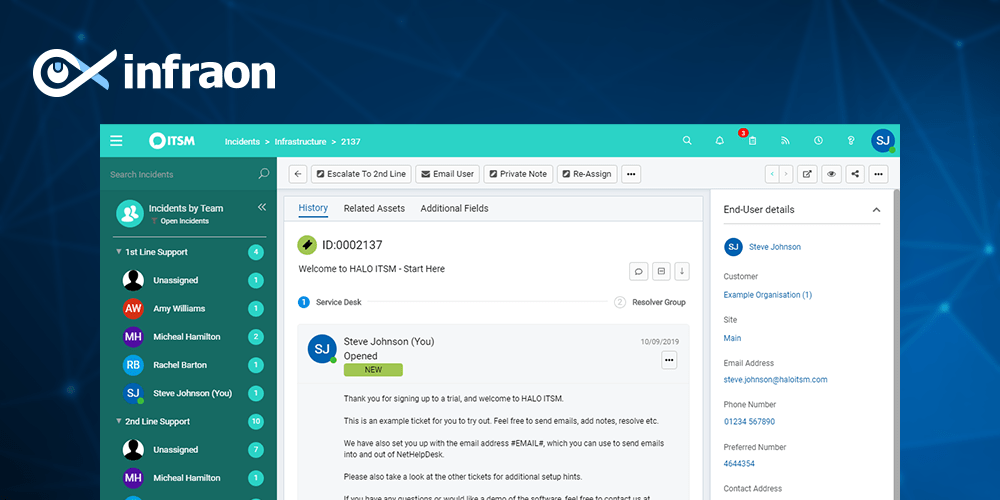
HaloITSM is a robust and comprehensive IT service management (ITSM) solution designed to streamline and enhance the efficiency of IT operations. It offers a wide range of features and capabilities to effectively manage and resolve IT incidents, problems, and service requests. With its intuitive and user-friendly interface, HaloITSM enables IT teams to track and prioritize tasks, collaborate seamlessly, and deliver high-quality services to their customers.
It allows IT teams to capture incident details, classify them based on severity and impact, assign them to the appropriate personnel, and track their progress until resolution. The platform also facilitates effective communication and collaboration among team members, ensuring that everyone stays informed about the incident’s status and any updates. With its robust reporting and analytics capabilities, HaloITSM enables organizations to analyze incident trends, identify areas for improvement, and make data-driven decisions to enhance their IT operations.
Pros:
- Intuitive and user-friendly interface, making it easy to navigate and use.
- Comprehensive ticket management system for efficient tracking and resolution of IT issues.
- Robust asset management capabilities to effectively manage and track IT assets.
- Automation features to streamline processes and improve efficiency.
- Integration with external tools and applications, providing seamless connectivity and enhancing collaboration.
- Customizable workflows to align with specific business needs.
Cons:
- Limited customization options compared to some other ITSM solutions.
- The learning curve may be steep for users who are not familiar with ITSM tools.
- Some advanced features may require additional configuration or customization.
- Integration with certain third-party tools may be limited or require extra effort.
- Certain features or functionalities may not be as robust as other ITSM solutions in the market.
- The availability of certain features or modules may depend on the specific pricing plan.
Related blog: Freshservice Asset Pricing Plan And Cost Guide
Final Note

Despite the attractive features offered by Jira Service Management, some users may seek alternatives due to its high pricing plans, inadequate reporting functions, and limited customization options. However, it’s important to note that the tools mentioned in this blog are worth considering as they can assist you in accomplishing your business objectives. The alternatives shared in this Jira Service Management comparison blog have been thoughtfully selected. If you’re still uncertain, we suggest considering Infraon ITSM—a low-code, robust, and user-friendly ITSM solution that is easy to implement.











